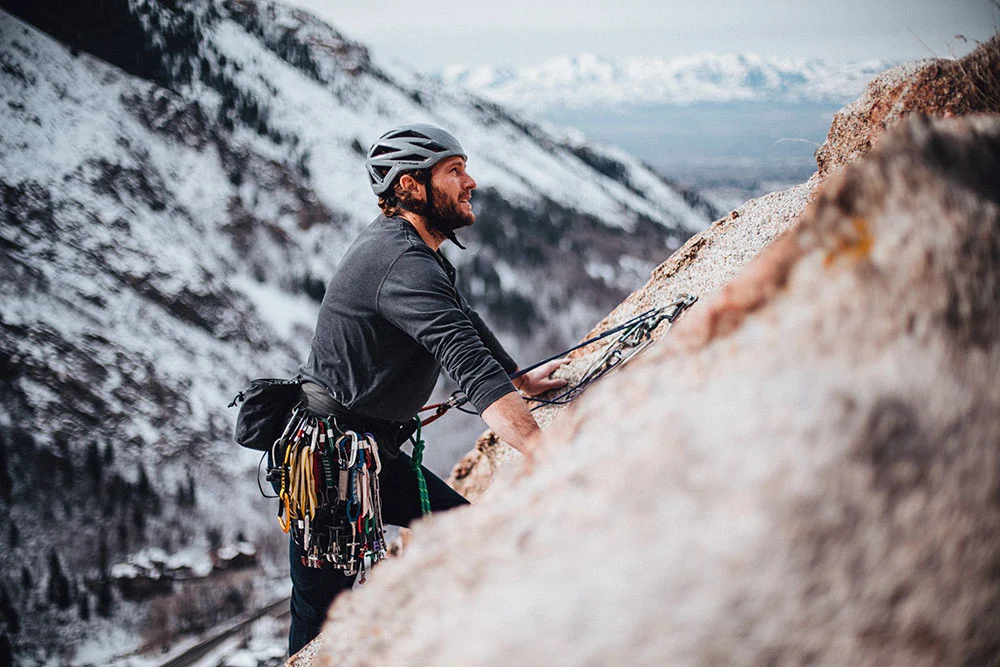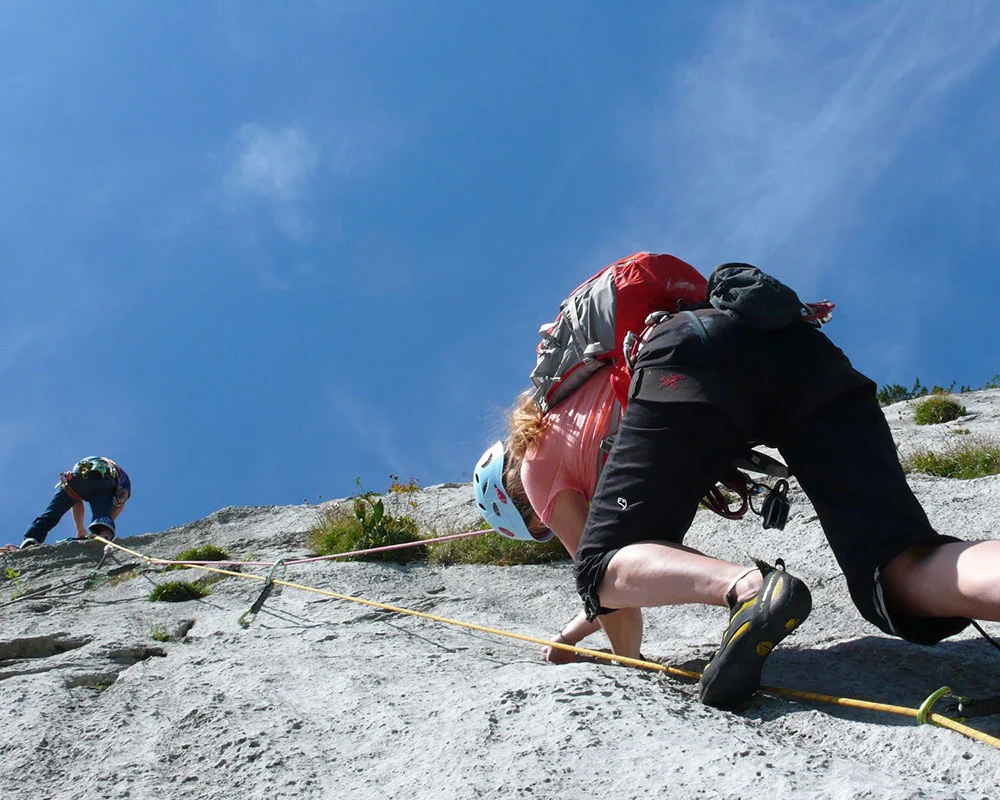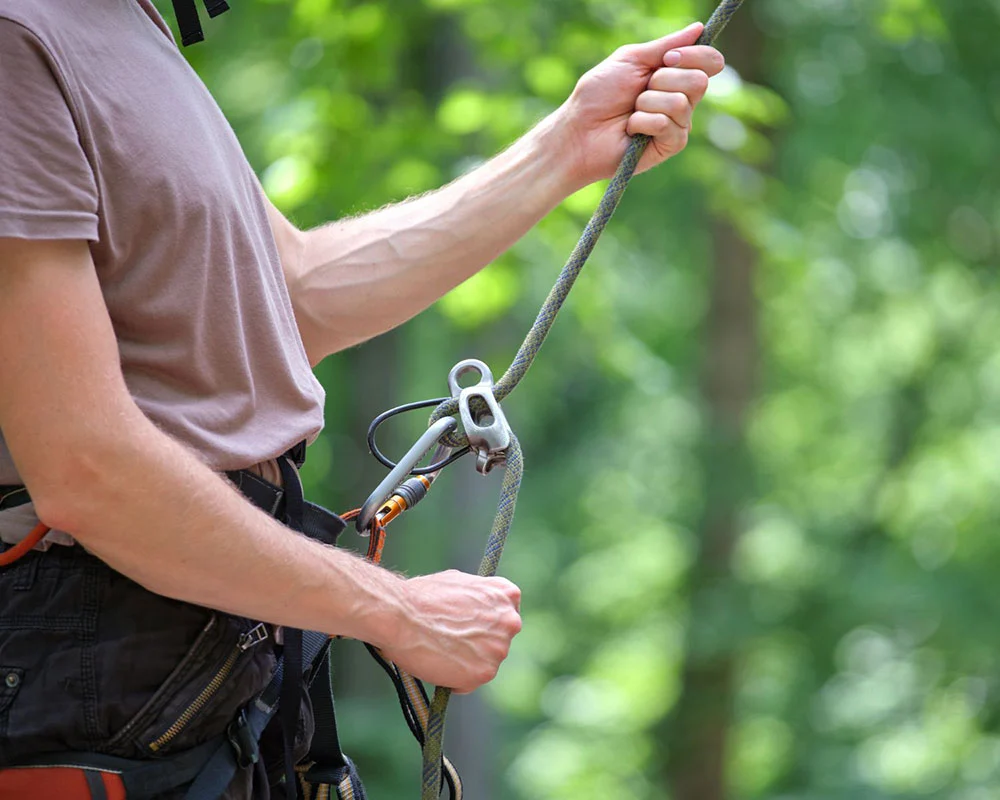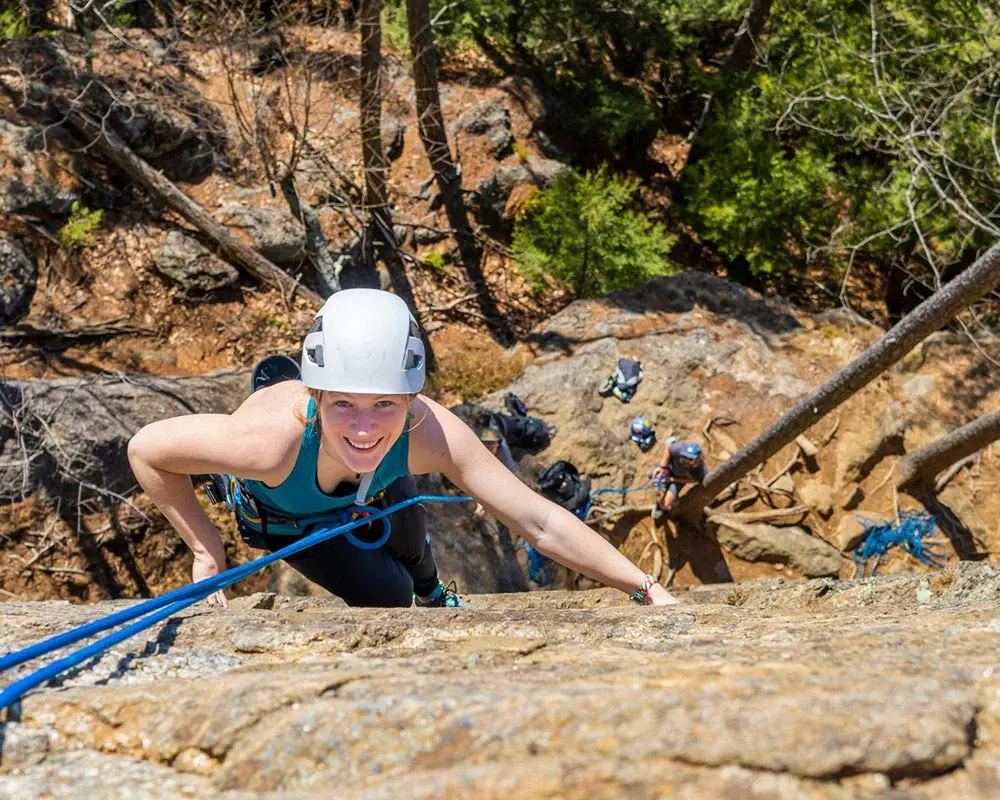Learn the fundamentals of top rope climbing, including what is top rope climbing, how it works, essential skills, anchor setup, safety measures, and climbing terminology to ensure a safe and enjoyable experience. Keep reading to master your skills!
Key Takeaways
- Top rope climbing is a type of climbing where a rope is anchored at the top of a climb and the climber is secured to the rope with a harness and belay device.
- Top rope climbing is a great way for beginners to get into climbing as it is a safer and less physically demanding than other forms of climbing.
- To get started with top rope climbing, you will need to find a climbing gym or outdoor climbing area, get proper equipment including a harness and shoes, and learn proper belay techniques.
- Climbing gyms typically offer classes or have staff members available to teach new climbers the basics of top rope climbing and belaying.
- Safety is paramount in top rope climbing and climbers should always double-check their gear and knots, communicate clearly with their belayer, and never climb beyond their ability level.
What Is Top Roping?
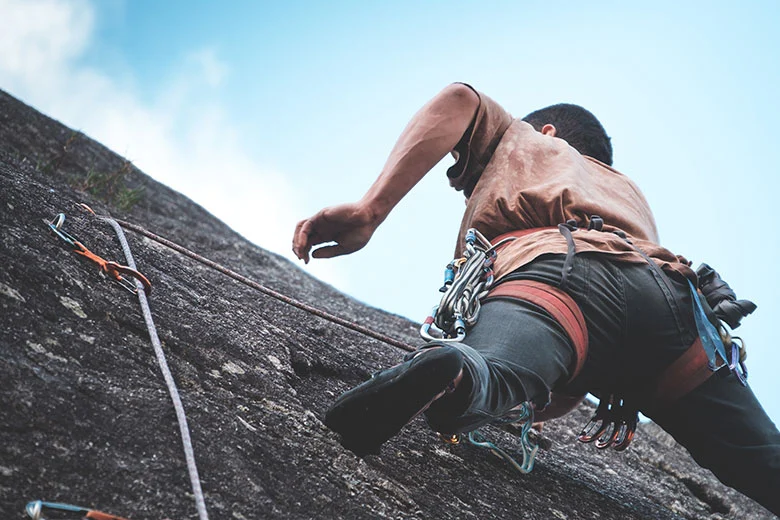
Top rope climbing is a popular and accessible style of rock climbing that is perfect for beginners. The climber is securely attached to a rope that runs up to an anchor at the top of the climbing route. The climber then descends with help from a belayer on the ground.
This setup provides increased safety and prevents long falls. Because it is less dangerous than other climbing disciplines, climbers can focus on developing their skills.
The beauty of top rope climbing lies in its versatility; it can be enjoyed both indoors and outdoors, with many gyms offering designated top rope routes specifically designed for beginners.
As climbers gain experience, they can easily transition from indoor gym challenges to thrilling outdoor crags where they can further hone their techniques while immersing themselves in nature.
Top Rope Climbing Vs. Other Climbing Styles
To understand top roping, see how it differs from other climbing disciplines like lead climbing, bouldering, sport climbing, and traditional (or trad) climbing.
Top Rope Climbing Vs. Lead Climbing
Want to learn even more about Top Rope Climbing Vs. Lead Climbing? Check out the video below:
Top rope climbing and lead climbing are two different popular styles of climbing before choosing one, the beginner rock climbers should consider the advantages and disadvantages of each.
| Top Rope Climbing | Lead Climbing |
| Considered the best starting point for beginners due to increased safety measures | Requires more advanced skills and knowledge and should only be attempted after gaining experience in climbing techniques. |
| Climbers are supported by a rope, secured to an overhead anchor | It is riskier because climbers must attach their rope to protection points as they ascend which requires learning techniques for managing rope, gear, and protection placement |
| Less physically demanding, as the rope provides additional support during the climb | Demands greater physical and mental strength due to the increased exposure and responsibility |
| Can be done both indoors and outdoors | Usually practiced outdoors since gyms have limited lead climbing routes and the more advanced techniques must be practiced outdoors |
Top Rope Climbing Vs. Bouldering
Want to learn even more Top Rope Climbing Vs Bouldering? Check out the video below:
Bouldering is another popular rock climbing style, this table explains the differences.
| Top Rope Climbing | Bouldering |
| Uses a harness and rope for safety. | No harness or rope, relying on crash pads and spotters for safety. |
| Routes tend to be longer, allowing for more sustained climbing. | Routes are shorter, focusing on powerful and technical moves. |
| Requires a belayer to manage the rope and catch falls. | No belayer needed, allowing for more independence and solo practice. |
| Can be done both indoors and outdoors. | Available indoors in gyms offering bouldering areas. Techniques must be mastered outdoors. |
| Develops endurance and footwork skills. | Helps build strength and problem-solving skills. |
| An excellent starting point for beginners in harness-and-rope climbing. | A popular entry point for those who prefer more independence and an emphasis on strength and technique. |
Top Rope Climbing Vs. Sport Climbing
Top Roping and Sport Climbing are two popular styles of climbing, each with its own unique set of characteristics and challenges. To understand the differences, study this table.
| Top Rope Climbing | Sport Climbing |
| Rope is secured to an overhead anchor | Climber clips into pre-placed bolts on the route as they ascend, providing protection |
| Can be done indoors or outdoors | Primarily an outdoor climbing style, though some gyms offer sport routes |
| Requires fewer specialized skills, making it more accessible for newcomers | Demands a higher skill level, including lead climbing, route finding, and quickdraw clipping techniques |
| Less physically demanding due to the security of the top rope | Often more physically challenging as climbers need to manage rope drag, clipping, and potential falls |
| Focuses on developing technique and improving strength without worrying about falling | Requires strong mental focus to manage fear and potential risks associated with lead climbing |
Considering your experience and skill level is essential when choosing which style is for you.
Top Rope Climbing Vs. Trad Climbing
While top roping and traditional (trad) climbing both use ropes for safety, the styles differ in many ways as explained in this table.
| Top Rope Climbing | Trad Climbing |
| Rope is secured to an overhead anchor which has been secured before the climb begins. | Climbers must place protective gear (such as cams or nuts) into the rock face to protect against falls |
| Can be done indoors or outdoors | Takes place outdoors on natural rock formations and routes are typically longer than routes in indoor gyms |
| Requires fewer specialized skills, making it more accessible for newcomers | Demands a higher skill level. The lead climber must place protective gear during the ascent and belay their partner up from above, |
| Less physically demanding due to the security of the top rope | Often more physically challenging as climbers need to manage rope drag, clipping, and potential falls |
| Focuses on developing technique and improving strength without worrying about falling | Requires strong mental focus to manage fear and potential risks associated with lead climbing |
Benefits of Top Rope Climbing
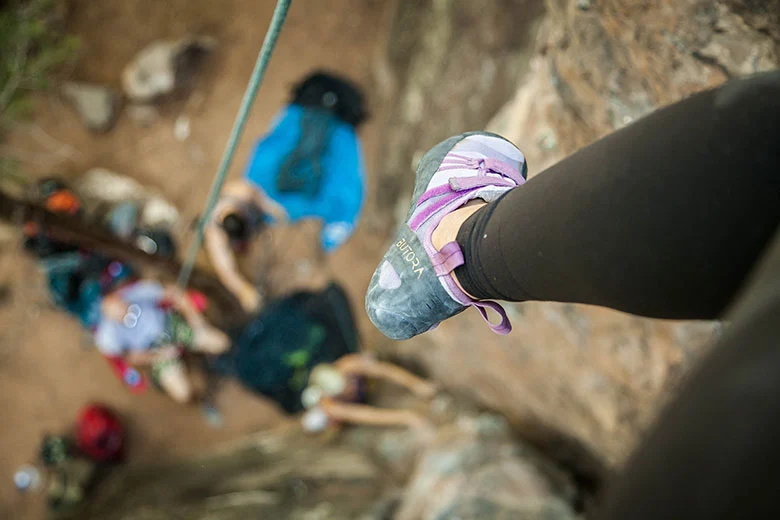
Top rope climbing is an excellent way for beginner rock climbers to develop critical skills and improve their technique. Unlike lead climbing, top rope allows beginners to focus on developing their movement skills without the added pressure of falling or worrying about gear placement.
1. Top roping helps beginners learn and improve climbing techniques by constantly challenging both body and mind.
2. Top roping helps you become familiar with different types of holds and surfaces that will prepare you for more challenging climbs in the future.
3. As you gain more experience in top roping, you’ll learn how to read routes, plan your moves strategically, and conserve energy.
4. Finally, top roping with friends or family can be an enjoyable social experience that strengthens relationships both on and off the wall.
One of the best things about top roping is that it’s relatively safe compared to other forms of climbing since the rope runs directly from the belayer up through an anchor at the top. This feature gives climbers a sense of security while learning how to climb without adding undue risks involved in tackling challenging routes immediately!
Benefits For Intermediate And Advanced Climbers
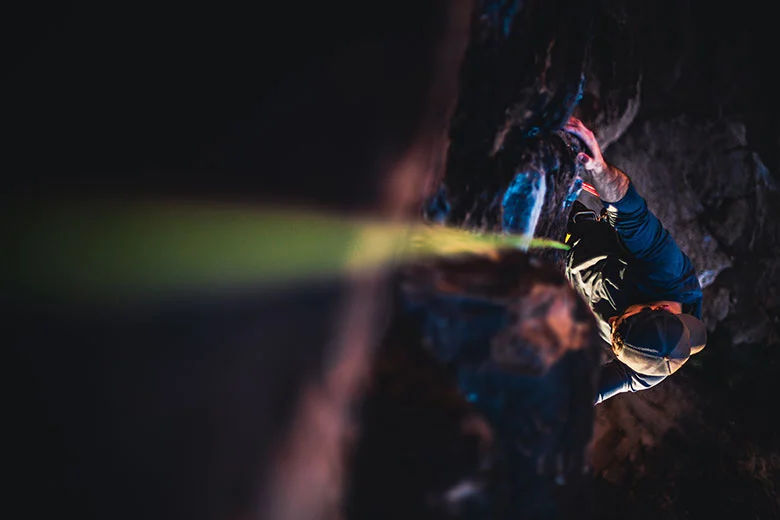
Top roping is not just for beginners; intermediate and advanced climbers can also benefit from this style of climbing. Here are some of the advantages for more experienced climbers:
1. Top roping allows the more advanced climber to focus on perfecting their technique without worrying about falling. This helps climbers master difficult moves and overcome fear, significantly improving their overall performance.
2. Top roping is a great way for climbers of all levels to build endurance. Climbers can push themselves by attempting longer routes, allowing them to gradually improve their stamina over time.
3. Top roping also allows experienced climbers to explore new areas and expand their skill set while maintaining a high level of safety.
The Basics Of Top Roping
Read on to learn the fundamentals of top rope climbing, including climbing terminology, required gear, essential skills, and safe anchor setup!
Climbing Terminology
Climbing terminology and proper communication are crucial in top rope climbing. Here are some of the most important climbing terms:
1. The climber is the person ascending
2. The belayer is the person providing support from below.
3. The anchor is the secure point at the top of a route where the rope is attached with carabiners or webbing.
4. Beta refers to information on how to climb a particular route successfully.
Climbing Communication
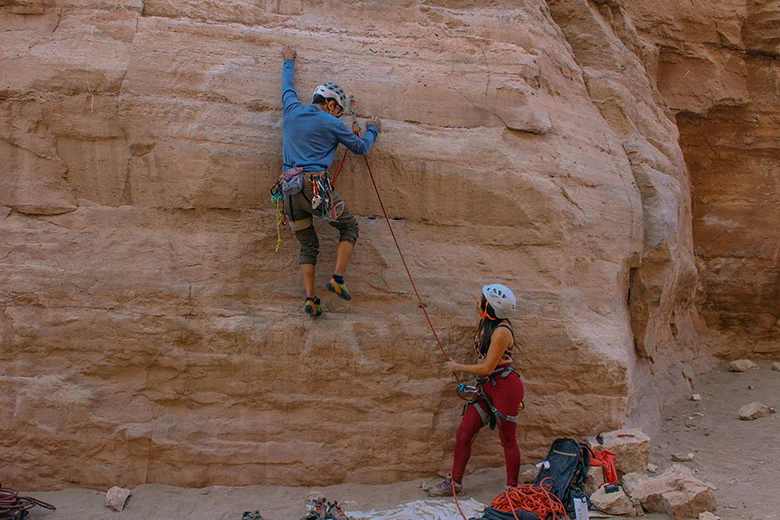
Communication between climbers is critical for safety and success.
1. When starting a climb, state clear commands such as “on belay” (ready for support) and “climbing” before beginning your ascent.
2. During a climb, it’s important to communicate with your belayer by using simple terms like “slack” (more rope) or “take” (stop giving slack).
Remember that clear communication minimizes misunderstandings and maximizes safety during your rock climbing journey!
Essential Gear for Top Roping
Want to learn even more Essential Gear for Top Roping? Check out the video below:
Top roping can be done indoors or outdoors, and having the right gear is essential to ensure maximum safety and enjoyment. Here are some of the essential gear for both indoor and outdoor top rope climbing:
- Climbing Rope: There are special ropes for climbing. Obtain the proper type of rope to provide a secure line in case of a fall.
- Harness: Harnesses are worn by both the climber and belayer to attach them to the climbing rope and distribute the force during a fall or while hanging.
- Climbing Shoes: Climbing shoes provide grip and sensitivity on the rock, allowing climbers to use small footholds and maintain balance on the wall.
- Helmet: Helmets protect the heads of the climber and belayer from falling rocks, debris, or potential impacts during a fall.
- Belay Device: The belay device creates friction on the rope, allowing the belayer to hold the rope securely and catch the climber in case of a fall.
- Locking Carabiners: Locking carabiners are used to connect the belay device, anchor systems, and personal anchor systems securely, preventing accidental opening during use.
- Webbing or Slings: Webbing and slings are used to create anchor systems or extend anchor points, reducing rope drag and providing a solid connection to the rock.
- Anchor Materials: Anchor materials, such as cordelettes, quickdraws, or pre-made anchor setups, are used to create secure and redundant anchor points at the top of the climb.
- Personal Anchor System (PAS) or Safety Tether: The PAS or safety tether connects the climber to the anchor while setting up or cleaning the top rope system, ensuring safety at all times.
- Chalk Bag and Chalk: Chalk improves grip on handholds by reducing moisture and sweat on the climber’s hands. It is usually kept in a bag clipped to the climber’s gear for easy access.
- Nut Tool: A nut tool is used to remove fixed gear or traditional protection from the rock during the cleaning process.
- Guidebook or Climbing App: Guidebooks and climbing apps provide essential information about climbing routes, grades, and access details for a particular climbing area.
- Rope Bag or Tarp: A rope bag or tarp keeps the climbing rope clean and organized, preventing tangles and protecting it from dirt and abrasion.
- Backpack: A backpack is used to carry all of the necessary climbing gear to and from the climbing area.
- First Aid Kit: A first aid kit provides essential medical supplies in case of injuries or emergencies while climbing.
- Approach Shoes or Hiking Boots: If top rope climbing outdoors, you’ll need approach shoes. Approach shoes or hiking boots protect the climber’s feet during the hike to the climbing area and provide necessary traction on uneven terrain. (Climbing shoes are only used during the climb).
Always double-check all equipment before climbing and seek professional advice if you are unsure about any part of setting up or using it correctly.
Top Rope Climbing Skills
To become a successful top rope climber, you must learn some basic skills described in this section.
1. Learn how to tie a figure-eight knot or bowline knot (used to fasten the rope onto your harness and create an anchor point for protection).
2. Master belaying techniques. Always maintain a taut rope between you and your belayer, don’t climb above your gear, and avoid sudden falls or jerky movements.
3. Learn route reading. This involves scouting out potential routes that suit your level of climbing expertise and deciphering handholds and footholds along with potential resting spots.
4. Finally, learning efficient movement techniques is essential to minimize the amount of energy expended.
The more advanced skills come into play after mastering these basics; they include lowering oneself down from anchors at the end of the route safely and tying back-up knots while dangling above empty space, adding extra security measures before restoring full weight to one’s hands, and feet alone following completion of each climb successfully.
Anchor Setup And Safety
Anchor setup is essential to practice top rope climbing safely. Here are some important tips to keep in mind:
1. Use high-quality equipment – Always use gear that is rated for climbing use and inspect the equipment before each climb.
2. Start with an established anchor – If you’re new to climbing, it’s always best to start with an anchor that has already been established by experienced climbers.
3. Choose a solid anchor point – Whether indoors or outdoors, ensure the anchor point is sturdy enough to hold the weight of both the climber and the belayer.
4. Check your connections – Double-check all connections before climbing to ensure everything is securely fastened.
6. Communicate with your belayer – Inform your belayer when you’re ready to begin and let them know if there are any concerns or problems during the climb.
Remember, safety should always be the first priority in rock climbing. By taking care when setting up anchors and adhering to proper safety practices, beginners can stay safe while enjoying this thrilling sport.
Essential Techniques for Top Roping
To become proficient in top-rope climbing, learning and practicing the following essential skills is essential.
Efficient Movement And Climbing Strategy
Efficient movement and climbing strategy are essential skills for top-rope climbers.
To save energy and climb effectively, planning each move before executing it is important. This involves looking at the route carefully and identifying where you can rest or use your body weight to your advantage. For example, when reaching for a hold above your head, make sure to engage your core muscles instead of relying on arm strength alone.
Another key factor in efficient movement is footwork. Using your feet as much as possible during climbing is crucial because feet provide more stability than hands. This means placing them deliberately on the holds rather than just standing on them haphazardly.
Finally, always remember to breathe steadily throughout the climb to maintain oxygen flow and reduce fatigue.
Practice climbing routes that challenge you but are still within your skill level so that you can continue improving your technique without unnecessary risks or strain on yourself.
As you progress in top-rope climbing, focus on practicing these techniques until they become second nature. By honing these strategies over time, you’ll be able to take on more difficult climbs confidently while enjoying the exhilarating experience of top-rope climbing!
Resting Techniques And Conservation Of Energy
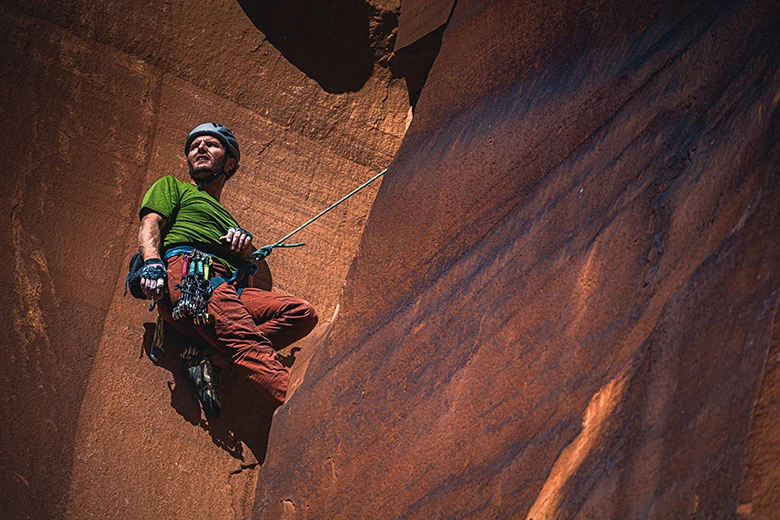
Resting techniques play a critical role in top roping, especially for beginners. It’s essential to conserve energy while climbing to avoid fatigue and injury.
One of the most common resting techniques is simply taking breaks on a route by hanging onto holds or ledges with your hands and feet. This technique helps rest muscles, take deep breaths, and increases blood flow to the body.
Another effective way to conserve energy is by using efficient movement strategies such as finding footholds that require less effort, maintaining balance throughout climbs, and eliminating unnecessary movements. As you climb higher up the wall or overhangs, it may be possible to find more comfortable spots where you can rest longer without completely stopping your ascent.
With practice and patience, climbers can develop their own unique set of skills that help maximize kinetic efficiency while minimizing energy expenditure. Implementing proper resting techniques combined with efficient movement strategies will enhance your overall climbing experience while preventing burnout and injuries during your rock-climbing journey as a beginner climber.
Reading Climbing Routes
Reading climbing routes is an essential skill for any top-rope climber. Before starting a climb, studying the route and planning your approach carefully is crucial. Look for features on the rock face that you can use as hand and foot holds. Pay attention to any obvious cracks or ledges that might make good resting spots along the way. Check out where each bolt or anchor point is located so you can pace yourself accordingly.
One great tip for reading climbing routes is to watch other climbers tackle the same route before attempting it yourself. This way, you can get a sense of how they navigate different sections and adjust your strategy if necessary. ‘
Another helpful technique is breaking down the climb into smaller sections, focusing on reaching one goal at a time rather than worrying about how high you are.
Finally, always remember to communicate clearly with your belayer while ascending the route. Let them know when you’re about to reach an anchor point or need more slack in the rope. By working together effectively, you’ll be able to confidently conquer even more challenging routes!
[convertkit form=5027836]
How to Determine the Difficulty Level of Climbing Routes
Top rope climbing can vary in difficulty depending on the route, but generally, it is considered to be less challenging than lead climbing or traditional climbing because of the added security of a top anchor and belayer support.
Grading Systems And Route Difficulty
As you progress in top rope climbing, you’ll encounter different grading systems that will help judge the difficulty of a route. North America’s most common grading system is the Yosemite Decimal System (YDS), which rates routes from 5.0 to 5.15c (as of 2021). A route’s grade takes into account factors such as steepness, length, and technicality.
It’s essential to note that grades can vary depending on location and climbing style, so don’t get too caught up with exact numbers. Instead, focus on challenging yourself at your current level and gradually progressing over time. Don’t be discouraged if you encounter a climb that feels too difficult – plateaus are part of the journey for all climbers.
Remember to communicate with fellow climbers and ask for their advice when it comes to finding appropriate graded routes according to your experience level- this can be an excellent way to learn new techniques!
Progression And Plateaus In Top Rope Climbing
As with any sport, progression in top rope climbing takes practice and patience. Climbers may reach a point where they feel stuck or unable to improve, known as a plateau. Plateaus can be frustrating but are natural in the learning process. One way to overcome them is by breaking down skills into smaller components and practicing each one individually until they become second nature.
Another way to progress in top rope climbing is by setting goals and pushing yourself out of your comfort zone. This could mean trying new routes that challenge you or attempting more challenging climbs with the help of an experienced climber. Don’t be afraid to ask for guidance or tips from others who have more experience.
Remember that everyone progresses at their own pace, so try not to compare yourself too much with others. Focus on your own journey and celebrate small victories along the way, such as successfully completing a climb you previously struggled with. With time, dedication, and practice, you’ll continue improving your rock climbing skills through top roping.
Safety Considerations
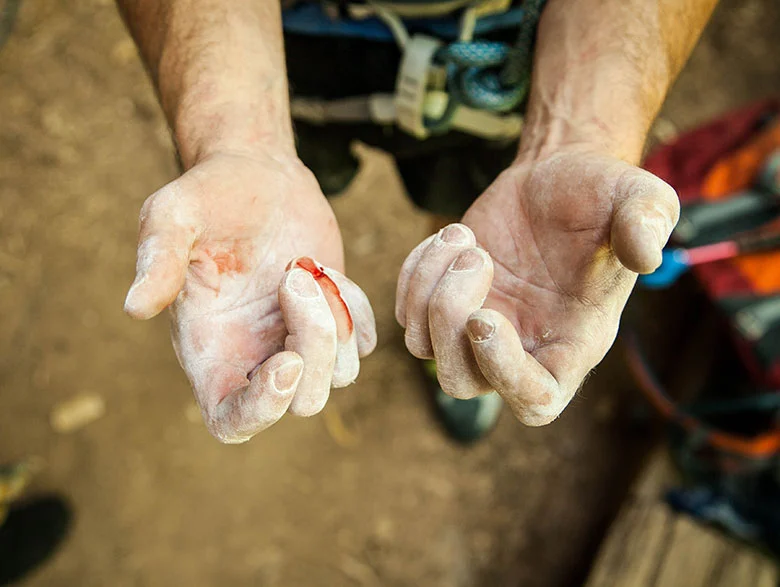
It is crucial to prioritize safety in top-rope climbing, including risk management and injury prevention, as well as environmental awareness and climbing ethics. Keep reading to learn how you can stay safe while enjoying this exciting activity.
Risk Management And Injury Prevention
Safety is the top priority when it comes to top rope climbing. Risk management and injury prevention are crucial aspects of every climb, especially for beginners. Before starting a climb, always check your gear for any damage or wear and tear. Ensure that your harness fits you correctly, and double-check your knot before ascending.
It’s essential to climb with a partner who understands belay techniques and has proper training in safety protocols. Clear communication between the climber and the belayer is necessary to prevent accidents. Always be aware of your surroundings and weather conditions before beginning a climb.
Injury prevention includes taking care of yourself both physically and mentally while climbing. Proper stretching will help reduce muscle fatigue while climbing, reducing the risk of injuries such as strains or sprains. Staying hydrated throughout the day is also vital, as dehydration can lead to decreased cognitive function and increased stress levels, which may impair judgment during climbs.
Remember that rest days are just as important as climbing days; overexertion can lead to burnout or repetitive motion injuries like rotator cuff strains or tendinitis. Be sure to listen to what your body needs so you don’t push too hard too fast on your rock-climbing journey!
Environmental Awareness And Climbing Ethics
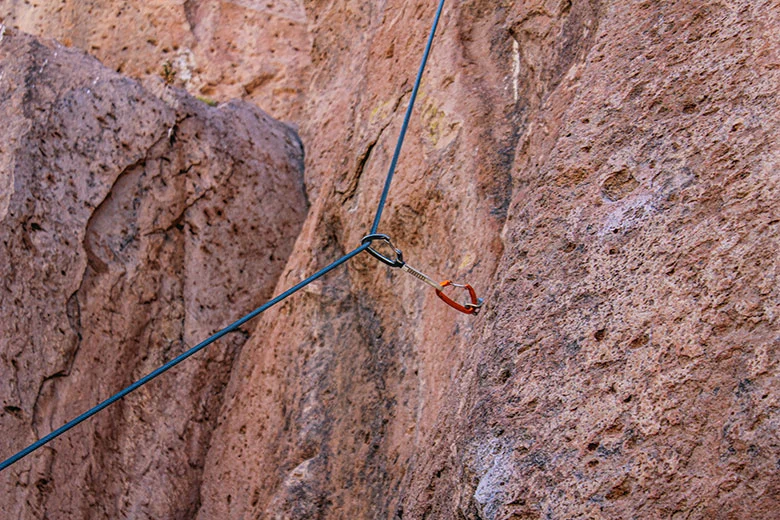
As a beginner rock climber, it’s essential to be aware of environmental concerns and ethical practices when climbing. One way to minimize your impact is by sticking to designated trails when approaching and leaving the climbing site. Avoid trampling vegetation, disturbing wildlife, or creating new paths that could damage the ecosystem.
Climbing ethics are also important in ensuring sustainability for future generations of climbers. Leave no trace behind, carry out all trash and gear you bring in with you, don’t mark or damage rocks or trees along the route, and respect local regulations and customs about bolting or equipment use.
By being mindful of our impact on the environment and following ethical guidelines established by local communities. Experienced climbers have set best practice examples to help us ensure we leave no lasting impact on the natural beauty around us while preserving routes for other climbers to enjoy!
Practical Tips To Get Started
Here are some tips about how to begin top roping that will make learning the climbing techniques and safety practices easier.
Join A Course
If you’re a beginner rock climber looking to get started with top-rope climbing, joining a course can help you learn the basics quickly and efficiently. Here are some reasons why:
1. Learn proper technique: A climbing course can teach you proper top rope techniques, such as how to tie knots and set up anchors.
2. Learn about safety procedures: Safety must come first in all climbing disciplines. In addition, knowing that you have the knowledge to keep yourself and others safe while climbing will give you the confidence to concentrate on your climbing skills.
3. Personalized feedback and advice: The instructor can give you feedback tailored to your specific level of experience and ability.
4. Obtaining Climbing Gear: By taking a course, you’ll also have access to necessary equipment like ropes, harnesses, and helmets without needing to purchase your gear right away.
5. Meeting other Climbers: Climbing courses offer an opportunity to meet climbers with similar interests and abilities who may become long-term partners or friends in the sport.
Overall, joining a course is an excellent way for new climbers to learn the necessary skills quickly, safely, and correctly so they can start enjoying the sport of rock climbing right away.
Hire A Guide
If you’re new to top roping and unsure where to start, consider hiring a guide. A guide can provide expert instruction on proper technique, gear selection, and climbing safety. Here are some benefits of hiring a guide:
1. Personalized Instruction: A guide can tailor their instruction to your individual needs and skills, helping you progress faster and more safely.
2. Gear Rental: Guides can often provide all the necessary gear for top rope climbing, so you don’t have to invest in expensive equipment upfront.
3. Safety First: Guides prioritize safety above all else and will ensure that your experience is as safe as possible.
4. Location Knowledge: Guides are also knowledgeable about the best locations for top rope climbing in your area, providing you with insider tips on the best routes and conditions.
5. Learn from Experience: Guides bring years of experience to the table, so you can learn from their expertise in outdoor adventure activities.
6. Confidence Building: With a trusted guide by your side, you’ll feel more confident attempting challenging climbs while improving skills under their guidance.
7. Fun & Adventure: Not only do guides provide valuable instruction, but they also create an enjoyable learning experience that adds excitement and adventure to your rock-climbing journey.
Overall, hiring a guide for top rope climbing is an excellent way for novice climbers to get started safely while also enjoying the sport’s thrill and adventure from day one.
Master Your Skills Indoors
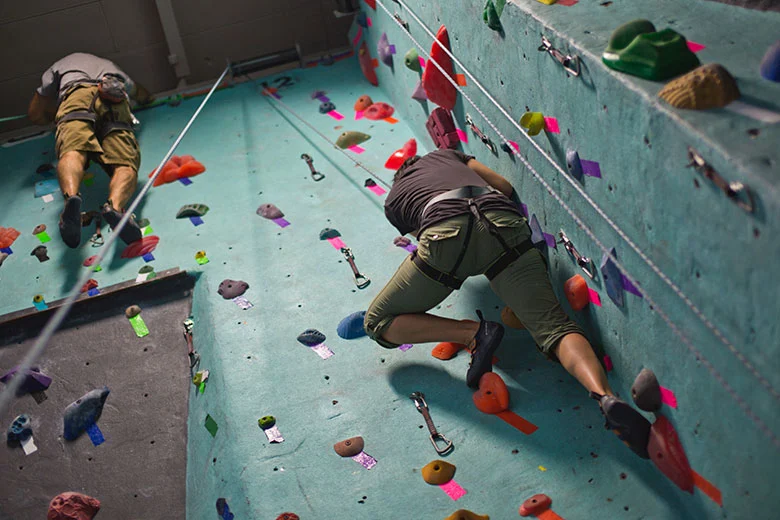
If you’re new to top rope climbing or need more practice,, mastering your skills indoors is an excellent way to gain confidence and build a solid foundation. Here are some tips on how to make the most of indoor climbing:
1. Start with easier climbs: Begin with routes rated below your skill level and slowly work up to harder ones as you progress.
2. Practice proper belaying techniques: Learn how to belay correctly by taking a course or practicing with an experienced climber. Always double-check your harnesses and equipment before starting.
3. Focus on footwork: Use your feet more than your arms when climbing. Place your feet securely on the holds, push down, and use them to propel yourself upwards.
4. Work on efficient movement: Climb smoothly and efficiently by using less energy with every move. Avoid over-gripping holds, take breaks when needed, and relax between climbs.
5. Experiment with different styles: Try out different types of holds, slopes, angles, and surfaces during indoor climbing sessions – this will help you develop more diverse skills that’ll come in handy outdoors.
6. Practice reading routes: Learn how to read climbs effectively by studying the route from below so that you know what’s coming ahead.
7. Get feedback: Ask for feedback from other climbers at the gym – they may spot things you missed or give you valuable tips for improvement!
By mastering these skills indoors, you’ll have a better experience during outdoor climbs, build endurance and become a better overall climber!
Finding Local Climbing Partners And Groups
If you’re new to rock climbing, finding local climbing partners and groups can greatly improve your skills and meet like-minded individuals. Here are some tips for finding them:
1. Check with your local climbing gym or outdoor store. They may have bulletin boards where climbers can connect with each other.
2. Join online climbing communities. Websites such as Meetup, Facebook groups, and forums like Reddit’s r/climbing are great resources for finding fellow climbers.
3. Attend local events and competitions: Local gyms or outdoor stores frequently sponsor local events and competitions. This is an excellent opportunity to meet experienced climbers who can guide you and help you progress.
5. Participate in organized trips: Local outdoor clubs or groups such as the American Alpine Club or the Access Fund organize outdoor trips and expeditions for climbers of varying ability levels.
Remember that safety should always come first when climbing with others, so it’s important to communicate effectively and ensure everyone is on the same page regarding gear, skill level, and experience. With proper precautions in place, finding local climbing partners and groups can be an excellent way to take your rock climbing journey to new heights!
Start Top Rope Climbing Today!
Top rope climbing is an exciting form of rock climbing that offers beginners a safe and accessible entry point into the world of harness-and-rope climbing. Using a pre-set anchor and rope with a harness for safety, top roping ensures maximum safety for novice climbers still mastering their skills.
Whether you prefer indoor or outdoor climbs, plenty of options are available to suit your needs and preferences. With a bit of practice and patience, you can master efficient movement, rest techniques, and other essential top-rope climbing skills to help you reach new heights on your rock-climbing journey.
So why not give it a try today? Your new rock climbing adventure awaits you!
Take your knowledge of top rope climbing to the next level with our extensive range of expert articles on top rope climbing.

